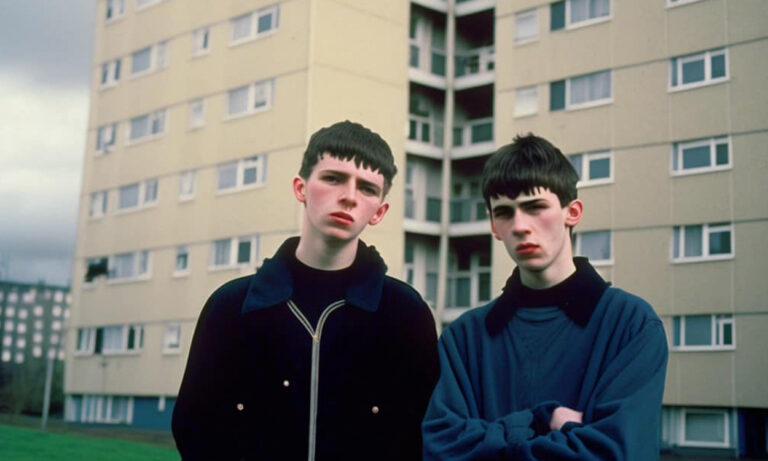Will AI-generated photographs spread false narratives about the past?
Mr Blobby on Love Island, teapots with six-packs, Guy Fieri drowning in a vat of soup: AI-rendered images from the depths of our (cursed) imaginations have made us belly laugh ever since the tools came into our hands. Many of these images look janky, with blurring and odd textures that let us know there’s no way they could ever be real.
Machine learning, however, is advancing faster than ever—and programs like DALL-E 2, Stable Diffusion, and Midjourney are now able to quickly churn out photorealistic images in a matter of seconds. A series of striking polaroids featuring black female goth and heavy metal fans in the late 90s recently went viral on Twitter, showing groups of women in distinctive leather outfits, band tees, and rock hairstyles. It’s hard to believe they’re not actual pictures unearthed from sweaty gigs of the past, but are instead the work of a Midjourney user called Fallon Fox.
If you look closely, it’s quite easy to pinpoint the uncanny valley phenomenon: the hands—a tell-tale sign of machine learning-generated images—often look wrong, sometimes with six-plus fingers gripping drinks weirdly. Some of the faces don’t look quite right either, with out-of-place noses and teeth. But there’s an overall ambience to the shots that feels very real. Nostalgic, even.
Other examples of this hyper-realistic photography being generated of the ‘past’ are surfacing as more users play around with the technology. There are pictures from inner-city Glasgow in 1985 with trackie-clad lads standing in front of tower blocks, and 90s rival gangs from LA playing dice games in colour-coordinated fits. Another user produced a depiction of queer culture in the past. None of them look perfect, but when viewed as thumbnails or perceived without a second thought, your eyes could easily gloss over the flaws.
“It is tricky [to differentiate human-shot photography from that created by AI], particularly when those photographs appear in contexts like social media, where our engagement with each image tends to be very brief,” Lewis Bush, a photographer and PhD researcher in Computational Photojournalism at the London School of Economics and Political Science, told SCREENSHOT. “There are still clues in many of these generated images as to their origins, but they tend to be hard to pick up on without a concentrated look at the image.”
It seems like we’re going to be inundated with hyperreal AI-generated photography pretty soon too. Stock image company Shutterstock has just inked a deal to add images created by DALL-E 2. At the same time, in a bid to reassure aggrieved photographers, it’s offering reimbursements to those whose images the AI has been trained on.
If the internet gets saturated with these kinds of photographs, which sit alongside real historical documentation, are we in danger of creating false narratives about the past? It’s worth noting that we’ve been able to edit and doctor images for years, dating back to the pre-Photoshop retouching used by the Soviet Union, and image manipulation is nothing new—AI isn’t doing anything that an advanced digital creator couldn’t accomplish.
These AI images of Glasgow in 1985 are blowing my mind
— Michael M 👽 (@michaelmphysics) November 22, 2022
👉https://t.co/zE2fougfhD pic.twitter.com/57fj5RVZli
That being said, these tools are increasingly being used by (almost) the entire world rather than a comparatively tiny group of people. So, should we be worried about machine-generated imagery becoming more advanced? Jon McCormack, a generative art researcher at Monash University, Australia, doesn’t think so. What he is concerned about however is “the overall aesthetic and ‘sameness’ of images generated using diffusion models.”
“Because they are trained on images from the internet, they mimic popular styles and aesthetic values, diminishing representations that aren’t as culturally homogeneous or ubiquitous,” McCormack shared. “Such machine learning systems just reinforce this ubiquity and sameness, ultimately at the expense of cultural diversity and creativity.”
TikTok user and digital artist @eli_other, who uses DALL-E 2 to generate images using text prompts like “a LEGO set coming home to his wife cheating on him” and “album cover for an all-horse metal band,” says he’s found that images generated by machines skew towards white male-centric themes. “For many of my prompts, I use neutral language like ‘person’ and about 60 per cent of the time the ‘person’ is a white man. Alongside that, it’s about 20 per cent white women and 20 per cent people of colour of any gender.”
Reactions to the Black goth and heavy metal fans on Twitter ranged from “perfect” and “beautiful” to “icky.” Non-white fans of that type of music did, of course, exist in the 90s, but the goth subculture has historically been associated with whiteness, and there’s a question about whether misrepresentations of the past could lead to skewed narratives about historic oppression. Fallon Fox, the former MMA fighter who’d used Midjourney to produce the polaroids, told Screen Rant that she was trying to “show a representation of people like [herself],” a Black trans woman, in the metal scene. “I put a lot of references to 90s-era Black goths in there,” she added.
With most innovations comes some kind of pushback and, just like any other picture, Bush believes that it’s “important to understand what it is that you’re looking at, and how that image has been produced.” And there are endless benign and educational purposes for this kind of photo generation. One of Bush’s projects, titled An Antique Land zine, uses machine learning to picture London after its fall to the ravages of climate change with green foliage sprouting out of the Natural History Museum.





